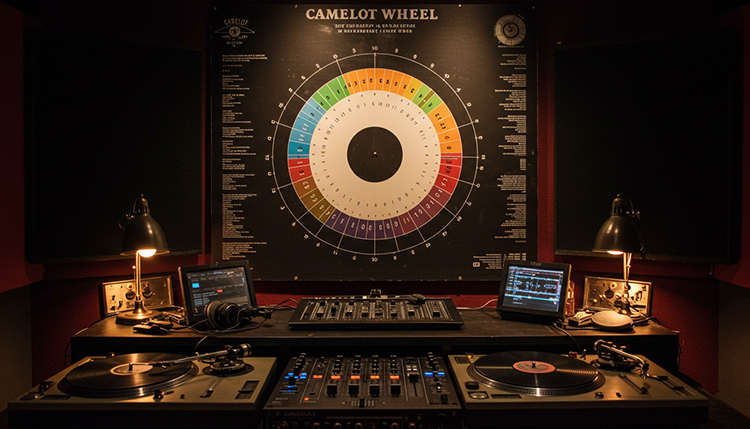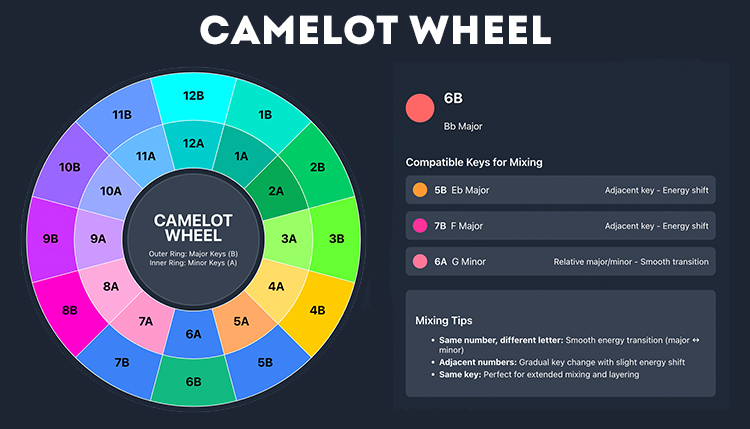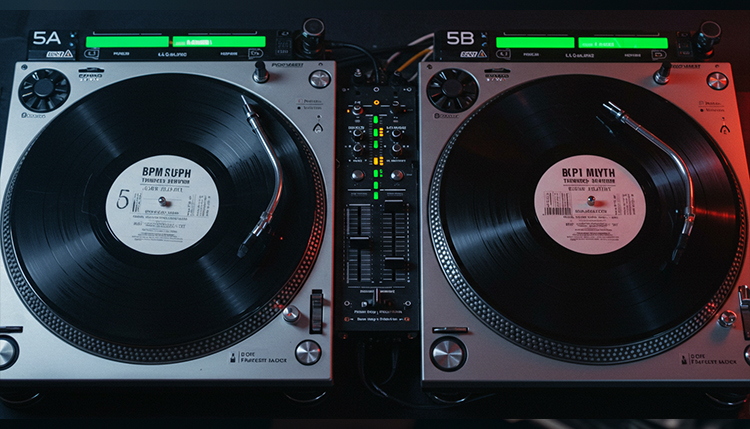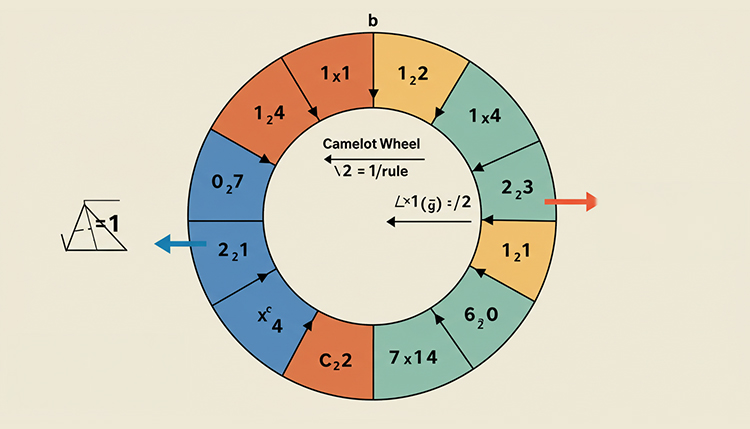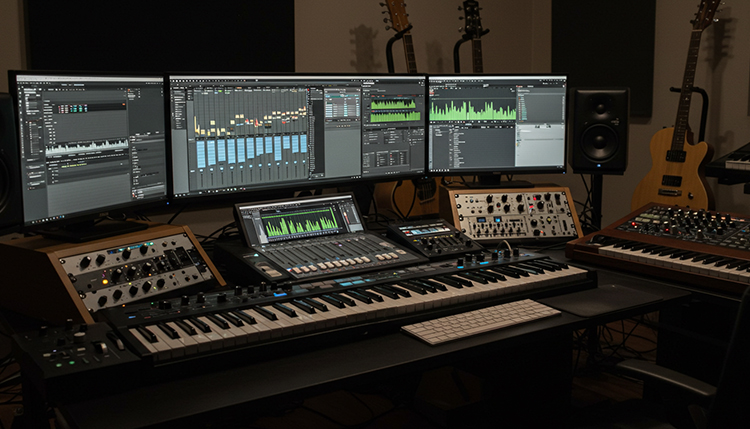Table of Contents
Camelot Wheel: Master Harmonic Mixing with Our Interactive DJ Tool
A majority of professional DJs use harmonic mixing as their primary technique for creating seamless transitions
This isn’t just some random stat – it’s the reality of modern DJing where crowd expectations have skyrocketed.
Gone are the days when DJs could get away with simple beatmatching and crossfading between random tracks.
Today’s dance floors demand smooth, musical transitions that keep the energy flowing and the vibe intact throughout an entire set.
The Camelot Wheel system has become the secret weapon that separates amateur bedroom DJs from professionals who command respect in clubs worldwide.
Every serious DJ needs a reliable Camelot Wheel tool to master harmonic mixing techniques that create unforgettable performances.
Whether someone’s spinning at underground warehouse parties or headlining major festivals, understanding key compatibility can make or break their reputation as a skilled DJ.
This interactive Camelot Wheel tool transforms complex music theory into something anyone can grasp, turning what once required years of musical education into an intuitive visual process that works in real-time during live sets.
What Is the Camelot Wheel System?
The Camelot Wheel emerged in the early 2000s when Mark Davis created a simplified notation system that would change DJ culture forever.
Before this revolutionary Camelot Wheel approach, DJs had to memorize traditional musical keys like C major, F# minor, and dozens of other combinations that frankly made most people’s heads spin.
Davis realized that DJs didn’t need to become classical musicians – they just needed a practical way to match compatible keys without getting bogged down in music theory.
The system uses numbers 1 through 12 paired with letters A (minor keys) and B (major keys), creating 24 total segments arranged in a circular pattern.
Think of it like a clock face, but instead of telling time, it reveals which songs will sound amazing together and which combinations will clear a dance floor faster than someone can say “key clash.”
Here’s where things get really clever – adjacent numbers work beautifully together for energy transitions, while matching numbers with different letters create those magical major-to-minor mood shifts that give listeners goosebumps.
The beauty lies in its simplicity.
A track labeled 8A will always harmonically match with 8B, 7A, 9A, and 8A (obviously).
No complicated circle of fifths memorization required, no music theory degree needed – just a simple visual system that works every single time.
Key aspects of the Camelot system include:
- 24 total key combinations covering all major scales and minor scales
- Numerical progression that mirrors natural harmonic relationships
- Letter designation for quick major/minor identification
- Visual wheel layout for instant compatibility checking
- Universal compatibility with all music genres and BPM ranges
Modern DJ software like Serato, Traktor, and rekordbox have embraced Camelot notation because it eliminates guesswork during live performance.
When someone’s mixing in front of hundreds of people, they need systems that work under pressure, not complex theories that require mental calculations.
The Camelot Wheel delivers exactly that – reliable, instant key matching that sounds professional every time.
How to Use Our Interactive Camelot Wheel Tool
This interactive Camelot Wheel tool transforms abstract music theory into something tangible that DJs can actually use during their sets.
The interface couldn’t be more straightforward – click any segment on the wheel to instantly see which keys will work harmonically with that selection.
Perfect matches glow green, while compatible keys light up in blue, creating a visual map of harmonic possibilities that beats memorizing Camelot Wheel charts any day.
The desktop version displays the full wheel with generous click targets, making it perfect for pre-set planning when DJs are building their track lists at home.
Mobile users get a touch-optimized experience that scales beautifully on phone screens, which is clutch for those moments when someone needs to check key compatibility while digging through crates at a record store.
The toggle switch for musical note display serves dual purposes – beginners can see traditional note names alongside Camelot notation, while experienced DJs can hide them for a cleaner interface.
Here’s how to maximize the tool’s potential:
- Start by clicking a key that represents your current track
- Note the green highlight – that’s your selected key
- Blue segments show all harmonically compatible options
- Adjacent numbers (±1) indicate energy transition possibilities
- Same number, different letter suggests major/minor mood shifts
- Use the musical notes toggle when learning traditional key relationships
During live sets, DJs can quickly reference the Camelot Wheel tool between tracks to confirm their next selection will maintain the harmonic flow.
The color-coding system works even in dimly lit DJ booths, where traditional printed charts become nearly impossible to read.
Smart DJs bookmark this Camelot Wheel tool on their mobile devices for instant access during gigs.
The responsive design automatically adjusts to screen size, so whether someone’s using a laptop for set preparation or checking compatibility on their phone between tracks, the experience remains consistent and functional.
Pro tip: experienced DJs often screenshot key combinations they plan to use during specific sets, creating quick reference guides for those high-pressure moments when the crowd’s energy depends on making the right harmonic choice.
Perfect Key Matching for Seamless Transitions
Perfect key matching is where the magic really happens in harmonic mixing.
When two tracks share the exact same Camelot key – say, both are 5A – they create what DJs call “perfect harmony,” where melodies, basslines, and chord progressions naturally complement each other without any musical tension.
This technique works especially well for extended blends where DJs want to layer tracks for 32 bars or more, creating those epic moments that make dance floors lose their minds.
The same-number, different-letter approach (like 5A to 5B) produces equally stunning results but adds emotional depth through major-minor transitions.
Picture this: a deep, melancholic house track in 5A gradually blends into an uplifting, euphoric anthem in 5B.
The harmonic relationship remains perfect, but the emotional journey takes listeners from introspection to celebration without jarring their musical expectations.
Energy management becomes an art form when DJs master adjacent-number transitions.
Moving from 8A to 9A typically increases energy, while dropping from 8A to 7A creates natural breakdowns that work beautifully for building tension before massive drops.
Essential perfect matching techniques include:
- Same-key layering for extended harmonic blends
- Energy climbing using +1 progressions (1A → 2A → 3A)
- Energy descent through -1 movements for breakdown sections
- Major-minor emotional shifts within same numbers
- Perfect fifth relationships for classical harmonic progressions
- Cross-genre matching using identical Camelot keys
Advanced DJs create entire hour-long journeys using strategic key progressions that tell musical stories.
They might start in 1A (deep and mysterious), climb through 2A and 3A (building energy), peak at 4B (euphoric major key), then descend through 3A and 2A before resolving back to 1A.
This creates narrative arc that keeps crowds engaged while maintaining perfect harmonic integrity throughout the entire set.
The biggest mistake beginners make is jumping randomly between keys without considering the harmonic journey.
Professional DJs plan their key progressions like composers writing symphonies, ensuring each transition serves the overall emotional arc of their performance.
Harmonic Mixing Rules Every DJ Should Know
The ±1 rule forms the foundation of professional harmonic mixing technique with any Camelot Wheel system.
This simple principle states that any key will mix harmonically with keys that are one position clockwise or counterclockwise on the Camelot Wheel.
So a track in 6A works perfectly with 5A, 7A, and 6B – no exceptions, no musical training required, just pure mathematical harmony that sounds amazing every single time.
Letter-switching (A to B or B to A) within the same number creates those spine-tingling major-minor transitions that separate good DJs from great ones.
These mood changes work because they maintain the same harmonic center while shifting the emotional character – think going from mysterious and dark to bright and uplifting without losing the musical thread.
Perfect fifth relationships happen naturally within the Camelot system, which is why using any Camelot Wheel sounds so damn good.
The traditional circle of fifths from music theory is built right into the wheel’s design, meaning DJs are using centuries-old harmonic principles without needing to understand the complex theory behind them.
Key clash identification saves sets from disaster.
When keys don’t relate harmonically (like mixing 1A with 6B), the result is musical chaos that sounds like someone playing two different songs in different rooms simultaneously.
Essential harmonic mixing rules:
- Never jump more than ±1 position without intermediary keys
- Same-letter transitions (A to A, B to B) maintain consistent mood
- Cross-letter switches create dramatic emotional shifts
- Perfect matches (same key) allow unlimited blending time
- Energy progression follows numerical sequence naturally
- Key clashing occurs with incompatible numerical relationships
Professional DJs develop internal clocks that help them time harmonic transitions perfectly.
They know that major-minor switches work best during breakdowns or build-ups, while energy transitions shine during drops or chorus sections.
This timing awareness transforms mechanical key matching into artistic expression that moves crowds emotionally.
Radio programmers use these same principles for playlist curation, creating hourlong segments that flow harmonically even when jumping between different artists and genres.
The rules work universally across musical styles because they’re based on fundamental acoustic principles that our ears recognize as naturally pleasing, regardless of whether we’re listening to house, techno, hip-hop, or pop music.
Camelot Wheel Applications Beyond DJing
Music producers have embraced the Camelot Wheel system for track arrangement and remix creation.
When building multi-track productions, producers use harmonic matching to ensure that layered elements work together musically rather than fighting for sonic space.
A producer might start with a bassline in 7A, add melodic elements in 7B for emotional contrast, then introduce percussion loops that complement the harmonic foundation.
Remix artists rely heavily on Camelot notation when selecting source material for mashups and bootlegs.
Finding an acapella vocal in 4A and an instrumental in 4B creates instant harmonic compatibility that would take hours to achieve through traditional pitch-shifting and musical guesswork.
Live bands benefit from Camelot Wheel harmonic mixing principles during set construction and song arrangement.
Rock bands can sequence their setlists using Camelot keys to create smooth energy flows between songs, while acoustic artists use the Camelot Wheel system to plan key changes within individual performances.
Educational applications extend far beyond DJ training programs.
Music theory instructors use the Camelot Wheel to demonstrate harmonic relationships visually, making abstract concepts tangible for students who struggle with traditional notation and theoretical explanations.
Applications across different fields include:
- Music production for harmonic layering and arrangement
- Remix creation and mashup compatibility checking
- Live band setlist construction and flow management
- Music education for visual harmony demonstration
- Radio programming and playlist development
- Collaborative projects between multiple producers
Radio programmers create “harmonic hours” where every song relates harmonically to create subconscious comfort for listeners.
This technique increases listener retention because the musical journey feels natural and intentional rather than random and jarring.
Wedding DJs use harmonic mixing to maintain celebration energy while accommodating requests from different musical eras and genres.
A skilled wedding DJ can transition from classic rock to modern pop to country music using Camelot keys, keeping the dance floor packed despite the musical diversity.
The system’s versatility proves that harmonic principles transcend genre boundaries and cultural differences.
Whether someone’s producing trap beats, mixing progressive house, or arranging classical music, the Camelot Wheel provides a universal language for harmonic compatibility that works across all musical styles and cultural contexts.
Mobile DJing with the Camelot Wheel
Mobile DJing presents unique challenges that make Camelot Wheel harmonic mixing tools absolutely essential for professional performance.
Unlike club DJs who work in familiar environments with consistent gear, mobile DJs face different venues, varying acoustics, and equipment limitations that demand quick, reliable harmonic decisions.
The touch-friendly interface becomes crucial when DJs are working with limited space and need to check key compatibility while managing multiple devices simultaneously.
Smart mobile DJs bookmark the interactive Camelot Wheel for instant access during gigs.
When someone’s mixing at a wedding reception and gets hit with unexpected requests, they can quickly verify harmonic compatibility before committing to a transition that might kill the dance floor energy.
Offline preparation strategies separate professional mobile DJs from weekend warriors.
Experienced DJs analyze their entire music library using Camelot notation, creating playlists organized by key relationships rather than just genre or BPM.
This preparation allows for spontaneous harmonic mixing even when internet connectivity fails or when working in venues with poor cell service.
Integration with popular DJ software enhances mobile performance capabilities significantly.
Apps like djay Pro, Cross DJ, and Virtual DJ display Camelot keys directly in their interfaces, but having a backup reference tool ensures continuity when technical issues arise.
Mobile DJing optimization strategies:
- Bookmark the Camelot Wheel tool for instant mobile access
- Create key-organized playlists for offline harmonic mixing
- Screenshot common key combinations for quick reference
- Practice touch-based key checking during setup time
- Develop backup strategies for connectivity failures
- Master one-handed operation for crowded DJ booths
Performance tips for mobile setups focus on efficiency and reliability under pressure.
Mobile DJs often work alone without technical support, making streamlined workflows essential for professional results.
The interactive Camelot Wheel tool provides visual confirmation that builds confidence during high-stakes moments when hundreds of people are watching and waiting for the next track.
Backup planning becomes critical for mobile DJs who can’t rely on venue technical support.
Smart mobile DJs maintain multiple access methods for Camelot Wheel harmonic mixing tools – smartphone apps, tablet interfaces, and even printed Camelot reference cards for absolute worst-case scenarios.
This redundancy ensures that harmonic mixing remains possible regardless of technical failures, equipment issues, or venue limitations that might derail less-prepared DJs.
Advanced Harmonic Mixing Techniques
Multi-key transitions represent the pinnacle of Camelot Wheel harmonic mixing artistry, where DJs create complex progressions that span multiple keys while maintaining perfect musical coherence.
These advanced techniques require deep understanding of harmonic relationships and impeccable timing, but the payoff is sets that sound more like live musical performances than simple track-to-track mixing.
Consider a DJ who starts in 1A, moves to 2A for energy building, shifts to 2B for emotional lift, progresses to 3B for peak energy, then resolves back through 3A and 2A before settling into 1B.
This six-key journey creates a complete musical narrative that takes listeners on an emotional rollercoaster while maintaining harmonic integrity throughout the entire progression.
Layering tracks in compatible keys opens up creative possibilities that single-track mixing simply cannot achieve.
Advanced DJs might run three or four tracks simultaneously – a percussion loop in 8A, a bassline in 8B, melodic elements in 7A, and vocals in 9A – creating complex harmonic textures that sound like original productions rather than DJ mixes.
Harmonic loops and extended mixes showcase true technical mastery.
DJs create 16-bar, 32-bar, or even 64-bar sections where multiple tracks blend seamlessly, building and releasing tension through strategic use of compatible keys and complementary musical elements.
Genre-specific approaches require understanding how different musical styles respond to harmonic mixing principles.
House music benefits from longer harmonic blends and gradual key progressions, while techno responds well to dramatic key shifts that emphasize percussive elements and rhythmic intensity.
Advanced techniques for experienced DJs:
- Multi-key progressions spanning 4-6 different harmonic centers
- Simultaneous layering of 3+ tracks in compatible keys
- Extended harmonic loops building tension over 64+ bars
- Genre-crossing using identical Camelot relationships
- Emotional storytelling through strategic key progression
- Live remixing using harmonic compatibility principles
Building emotional journeys through key selection transforms DJing from entertainment into art form.
Master DJs understand that different keys evoke different emotional responses – minor keys (A) tend toward introspection and mystery, while major keys (B) create celebration and euphoria.
By strategically planning key progressions, DJs craft emotional experiences that mirror the natural flow of human feeling throughout a night of dancing.
Professional workflow integration means incorporating Camelot Wheel harmonic mixing principles into every aspect of DJ preparation and performance.
Top-tier DJs analyze new music acquisitions using Camelot notation, organize their digital libraries by harmonic relationships, and plan entire sets around key progressions that support their artistic vision.
This level of preparation allows for spontaneous creativity during live performance because the harmonic foundation has been carefully constructed to support musical exploration and improvisation.
The Wrap Up
The Camelot Wheel system has revolutionized how DJs approach harmonic mixing, transforming complex music theory into an intuitive visual tool that anyone can master.
From bedroom beginners to international headliners, DJs worldwide rely on these Camelot Wheel harmonic principles to create seamless transitions that keep dance floors moving and crowds engaged.
This interactive Camelot Wheel tool puts professional-level harmonic mixing capabilities right at everyone’s fingertips, whether they’re planning sets at home or making split-second decisions during live performance.
The beauty of the Camelot Wheel system lies in its universal applicability – the same principles that work for underground techno apply equally to commercial pop, wedding receptions, and experimental electronic music.
Smart DJs customize their approach based on their specific needs and musical styles.
Club DJs might focus on extended harmonic blends and energy management, while mobile DJs emphasize quick compatibility checking and crowd-pleasing transitions.
Radio programmers use the Camelot Wheel system for playlist flow, while producers apply harmonic matching to remix creation and track arrangement.
The key is understanding that harmonic mixing isn’t about following rigid rules – it’s about having reliable tools that support creative expression and musical storytelling.
Whether someone’s just starting their DJ journey or looking to refine advanced techniques, the Camelot Wheel provides a foundation for musical growth that will serve them throughout their entire career behind the decks.

